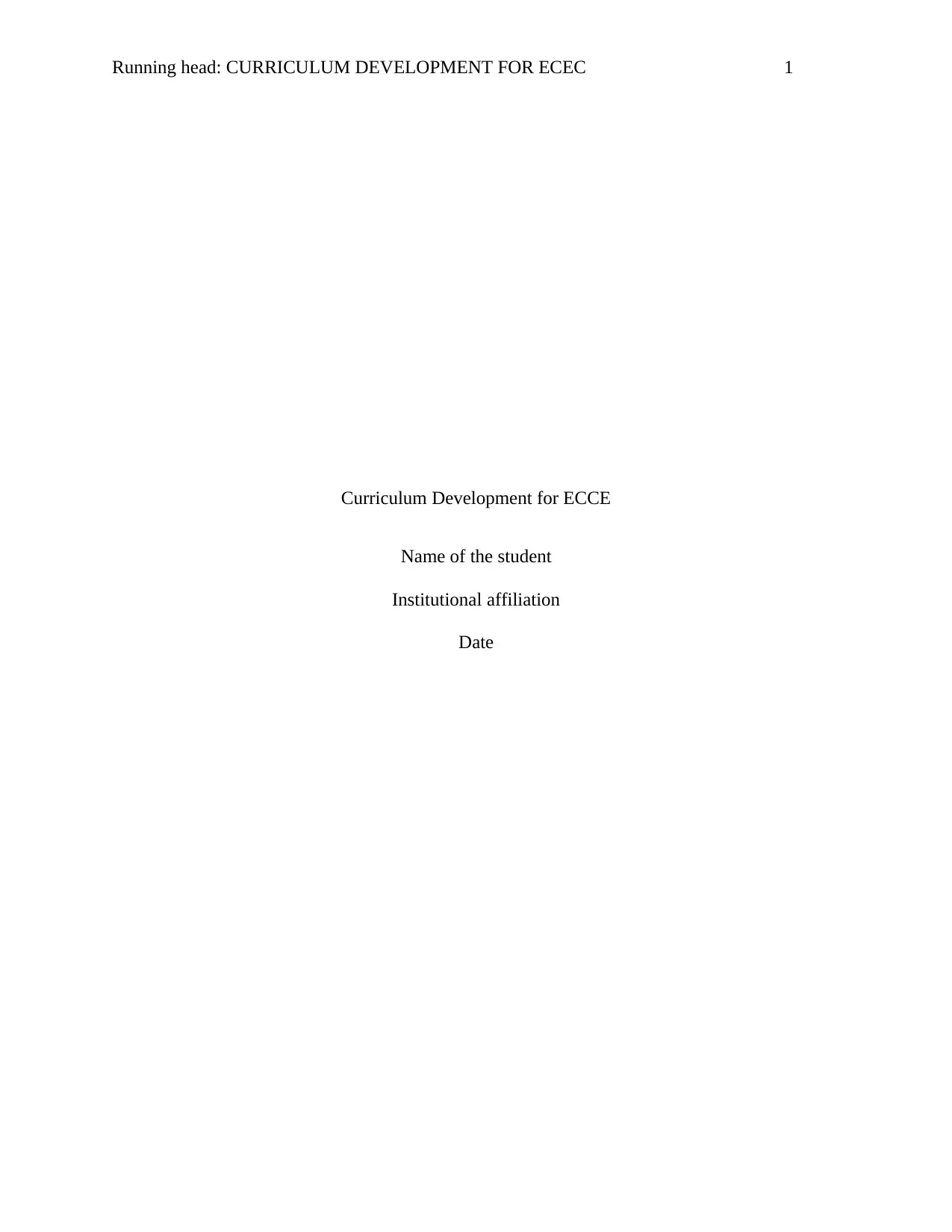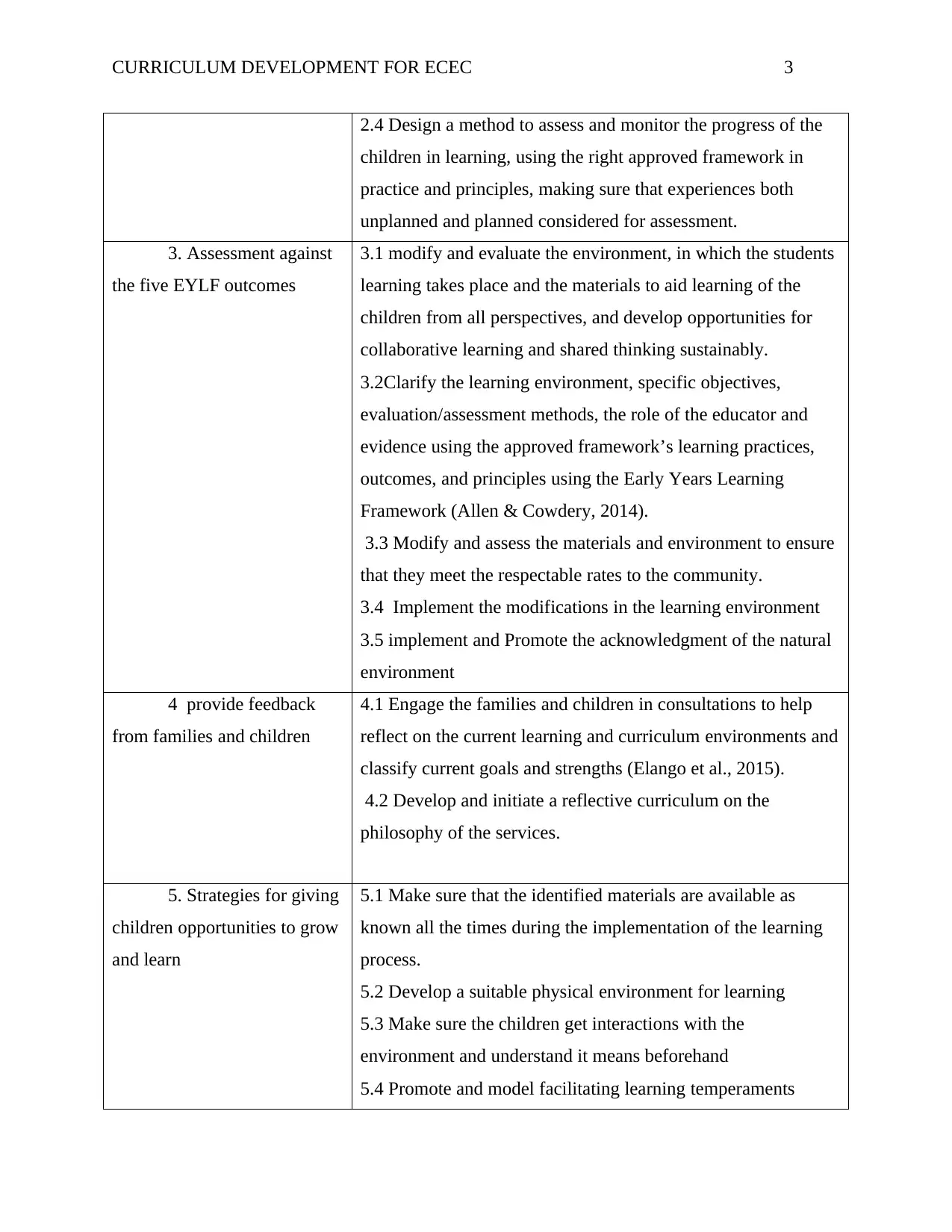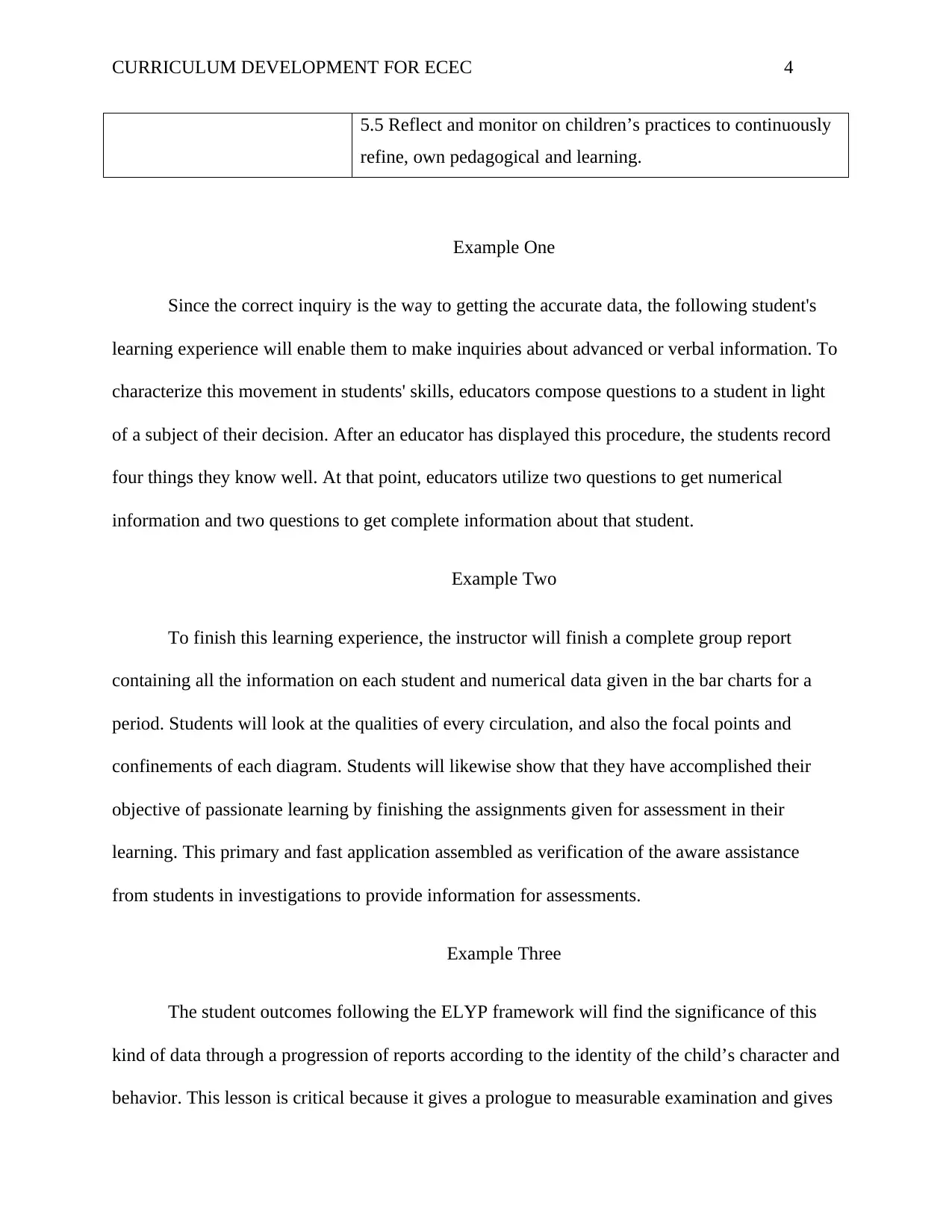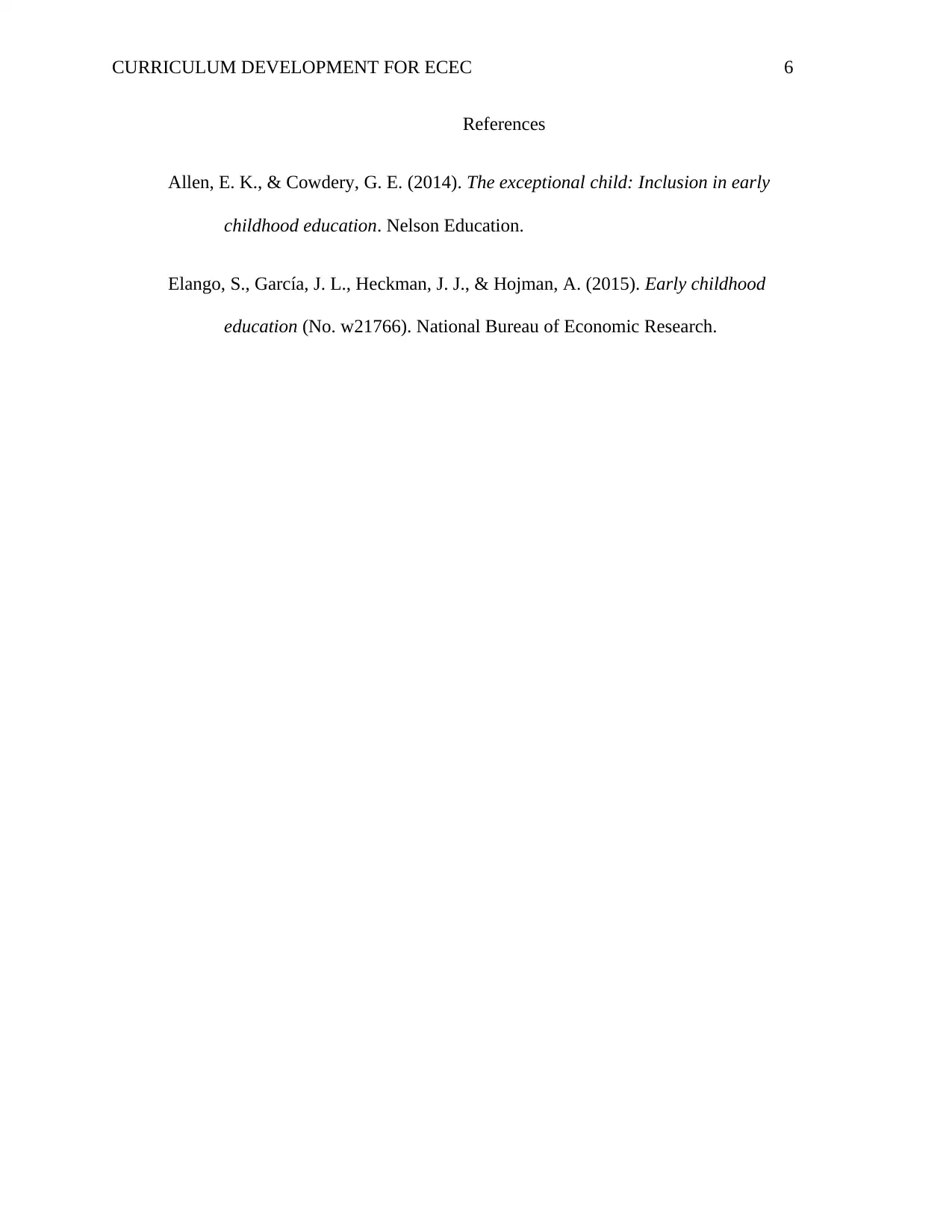ECEC Curriculum Development: Knowledge, Skills, and Application
VerifiedAdded on 2023/06/05
|6
|1255
|495
Report
AI Summary
This report provides an overview of curriculum development for Early Childhood Education and Care (ECEC), focusing on the knowledge and skills required by educators to design, implement, and evaluate effective curricula for foster children. It outlines a curriculum template that includes elements, performance criteria, and outcomes related to evaluating and assessing children's learning, aligning with the Early Years Learning Framework (EYLF). The report details methods for gathering information from children, analyzing their strengths and weaknesses, and planning learning experiences to promote holistic development. It also discusses modifying and evaluating the learning environment, providing feedback from families and children, and implementing strategies to foster children's growth and learning through various examples and practical applications. The document emphasizes the importance of creating a supportive learning environment and continuously refining pedagogical practices.

Running head: CURRICULUM DEVELOPMENT FOR ECEC 1
Curriculum Development for ECCE
Name of the student
Institutional affiliation
Date
Curriculum Development for ECCE
Name of the student
Institutional affiliation
Date
Paraphrase This Document
Need a fresh take? Get an instant paraphrase of this document with our AI Paraphraser

CURRICULUM DEVELOPMENT FOR ECEC 2
Application
The curriculum below indicates the knowledge and skills needed by the educators in
designing, implementing and evaluating the foster children curriculum in the development of the
children and learning. The information is applicable to the educators within the care services and
education range. No legislative, licensing or certification needed for the unit below during its
application (Allen & Cowdery, 2014). The implantation the curriculum will be done in the
following template;
ELEMENT PERFORMANCE CRITERIA
Outcomes defined by
the Elements
Describes what needs to be done regarding the performance to
specify the performance level required to exhibit the results of
the element (Allen & Cowdery, 2014).
1. Evaluate and assess
unplanned and planned
learning and teaching
1.1 Establish or use chances to acquire information from the
children and the families.
1.2 Collect information by applying different measuring
techniques to evaluate and assess learning and teaching, using
the appropriate framework.
1.3 make sure that evaluation and assessment of the student’s
learning and curriculum experiences are by the framework
requirements and are regular.
1.4 Use evaluation and assessment to improve on the future
designs of the learning experiences and curriculum.
2. How children’s
learning will be evaluated
2.1 gather information from each child
2.2 analyze the data from each child to identify the strengths,
weaknesses, interests, and goals of each child in line with
learning framework approved by relevant bodies.
2.3 plan the experiences in learning to promote a holistic style
of learning and to provide transitions and continuity of learning
(Elango, García, Heckman, & Hojman, 2015).
Application
The curriculum below indicates the knowledge and skills needed by the educators in
designing, implementing and evaluating the foster children curriculum in the development of the
children and learning. The information is applicable to the educators within the care services and
education range. No legislative, licensing or certification needed for the unit below during its
application (Allen & Cowdery, 2014). The implantation the curriculum will be done in the
following template;
ELEMENT PERFORMANCE CRITERIA
Outcomes defined by
the Elements
Describes what needs to be done regarding the performance to
specify the performance level required to exhibit the results of
the element (Allen & Cowdery, 2014).
1. Evaluate and assess
unplanned and planned
learning and teaching
1.1 Establish or use chances to acquire information from the
children and the families.
1.2 Collect information by applying different measuring
techniques to evaluate and assess learning and teaching, using
the appropriate framework.
1.3 make sure that evaluation and assessment of the student’s
learning and curriculum experiences are by the framework
requirements and are regular.
1.4 Use evaluation and assessment to improve on the future
designs of the learning experiences and curriculum.
2. How children’s
learning will be evaluated
2.1 gather information from each child
2.2 analyze the data from each child to identify the strengths,
weaknesses, interests, and goals of each child in line with
learning framework approved by relevant bodies.
2.3 plan the experiences in learning to promote a holistic style
of learning and to provide transitions and continuity of learning
(Elango, García, Heckman, & Hojman, 2015).

CURRICULUM DEVELOPMENT FOR ECEC 3
2.4 Design a method to assess and monitor the progress of the
children in learning, using the right approved framework in
practice and principles, making sure that experiences both
unplanned and planned considered for assessment.
3. Assessment against
the five EYLF outcomes
3.1 modify and evaluate the environment, in which the students
learning takes place and the materials to aid learning of the
children from all perspectives, and develop opportunities for
collaborative learning and shared thinking sustainably.
3.2Clarify the learning environment, specific objectives,
evaluation/assessment methods, the role of the educator and
evidence using the approved framework’s learning practices,
outcomes, and principles using the Early Years Learning
Framework (Allen & Cowdery, 2014).
3.3 Modify and assess the materials and environment to ensure
that they meet the respectable rates to the community.
3.4 Implement the modifications in the learning environment
3.5 implement and Promote the acknowledgment of the natural
environment
4 provide feedback
from families and children
4.1 Engage the families and children in consultations to help
reflect on the current learning and curriculum environments and
classify current goals and strengths (Elango et al., 2015).
4.2 Develop and initiate a reflective curriculum on the
philosophy of the services.
5. Strategies for giving
children opportunities to grow
and learn
5.1 Make sure that the identified materials are available as
known all the times during the implementation of the learning
process.
5.2 Develop a suitable physical environment for learning
5.3 Make sure the children get interactions with the
environment and understand it means beforehand
5.4 Promote and model facilitating learning temperaments
2.4 Design a method to assess and monitor the progress of the
children in learning, using the right approved framework in
practice and principles, making sure that experiences both
unplanned and planned considered for assessment.
3. Assessment against
the five EYLF outcomes
3.1 modify and evaluate the environment, in which the students
learning takes place and the materials to aid learning of the
children from all perspectives, and develop opportunities for
collaborative learning and shared thinking sustainably.
3.2Clarify the learning environment, specific objectives,
evaluation/assessment methods, the role of the educator and
evidence using the approved framework’s learning practices,
outcomes, and principles using the Early Years Learning
Framework (Allen & Cowdery, 2014).
3.3 Modify and assess the materials and environment to ensure
that they meet the respectable rates to the community.
3.4 Implement the modifications in the learning environment
3.5 implement and Promote the acknowledgment of the natural
environment
4 provide feedback
from families and children
4.1 Engage the families and children in consultations to help
reflect on the current learning and curriculum environments and
classify current goals and strengths (Elango et al., 2015).
4.2 Develop and initiate a reflective curriculum on the
philosophy of the services.
5. Strategies for giving
children opportunities to grow
and learn
5.1 Make sure that the identified materials are available as
known all the times during the implementation of the learning
process.
5.2 Develop a suitable physical environment for learning
5.3 Make sure the children get interactions with the
environment and understand it means beforehand
5.4 Promote and model facilitating learning temperaments
⊘ This is a preview!⊘
Do you want full access?
Subscribe today to unlock all pages.

Trusted by 1+ million students worldwide

CURRICULUM DEVELOPMENT FOR ECEC 4
5.5 Reflect and monitor on children’s practices to continuously
refine, own pedagogical and learning.
Example One
Since the correct inquiry is the way to getting the accurate data, the following student's
learning experience will enable them to make inquiries about advanced or verbal information. To
characterize this movement in students' skills, educators compose questions to a student in light
of a subject of their decision. After an educator has displayed this procedure, the students record
four things they know well. At that point, educators utilize two questions to get numerical
information and two questions to get complete information about that student.
Example Two
To finish this learning experience, the instructor will finish a complete group report
containing all the information on each student and numerical data given in the bar charts for a
period. Students will look at the qualities of every circulation, and also the focal points and
confinements of each diagram. Students will likewise show that they have accomplished their
objective of passionate learning by finishing the assignments given for assessment in their
learning. This primary and fast application assembled as verification of the aware assistance
from students in investigations to provide information for assessments.
Example Three
The student outcomes following the ELYP framework will find the significance of this
kind of data through a progression of reports according to the identity of the child’s character and
behavior. This lesson is critical because it gives a prologue to measurable examination and gives
5.5 Reflect and monitor on children’s practices to continuously
refine, own pedagogical and learning.
Example One
Since the correct inquiry is the way to getting the accurate data, the following student's
learning experience will enable them to make inquiries about advanced or verbal information. To
characterize this movement in students' skills, educators compose questions to a student in light
of a subject of their decision. After an educator has displayed this procedure, the students record
four things they know well. At that point, educators utilize two questions to get numerical
information and two questions to get complete information about that student.
Example Two
To finish this learning experience, the instructor will finish a complete group report
containing all the information on each student and numerical data given in the bar charts for a
period. Students will look at the qualities of every circulation, and also the focal points and
confinements of each diagram. Students will likewise show that they have accomplished their
objective of passionate learning by finishing the assignments given for assessment in their
learning. This primary and fast application assembled as verification of the aware assistance
from students in investigations to provide information for assessments.
Example Three
The student outcomes following the ELYP framework will find the significance of this
kind of data through a progression of reports according to the identity of the child’s character and
behavior. This lesson is critical because it gives a prologue to measurable examination and gives
Paraphrase This Document
Need a fresh take? Get an instant paraphrase of this document with our AI Paraphraser

CURRICULUM DEVELOPMENT FOR ECEC 5
students exhibit passionate capability to look for help and look for assistance from individuals
from others. It is a fundamental ability in arithmetic and life, as students frequently confront
difficulties and need viable methodologies to conquer them.
Example Four
For the proper understanding of the tasks, the children will do an assignment that would
require them to finish with their parents or foster parents. The purpose of this assessment is to
engage the child with family members in the process of teaching which the educators would
evaluate according to the EYLF. An example of the assignment would require that child to ask
help from the parent or the foster parent to cut a ribbon and help complete the formation of a gift
box already started at school. The purpose of this assessment would indicate that the student
would have to explain to the parent the exact things that they would do to make the box
complete. Additionally, after teaching, they will both work together in the process of making the
table and hence incorporating their assistance.
Example Five
In the strategies to improve children’s learning, the educator will characterize students'
experiences; the educator will collect the materials for use in class at the time of the start of the
lesson. The students will compose questions to a colleague in light of a subject of their liking.
After an educator has displayed this procedure, the students record four things they know well.
To center on the real utilization of these strategies, students will pick one of nine subjects they
consider their best. Cooperating students design mathematical modeling, science, creative art,
and design will help identify the best areas of environment suits them.
students exhibit passionate capability to look for help and look for assistance from individuals
from others. It is a fundamental ability in arithmetic and life, as students frequently confront
difficulties and need viable methodologies to conquer them.
Example Four
For the proper understanding of the tasks, the children will do an assignment that would
require them to finish with their parents or foster parents. The purpose of this assessment is to
engage the child with family members in the process of teaching which the educators would
evaluate according to the EYLF. An example of the assignment would require that child to ask
help from the parent or the foster parent to cut a ribbon and help complete the formation of a gift
box already started at school. The purpose of this assessment would indicate that the student
would have to explain to the parent the exact things that they would do to make the box
complete. Additionally, after teaching, they will both work together in the process of making the
table and hence incorporating their assistance.
Example Five
In the strategies to improve children’s learning, the educator will characterize students'
experiences; the educator will collect the materials for use in class at the time of the start of the
lesson. The students will compose questions to a colleague in light of a subject of their liking.
After an educator has displayed this procedure, the students record four things they know well.
To center on the real utilization of these strategies, students will pick one of nine subjects they
consider their best. Cooperating students design mathematical modeling, science, creative art,
and design will help identify the best areas of environment suits them.

CURRICULUM DEVELOPMENT FOR ECEC 6
References
Allen, E. K., & Cowdery, G. E. (2014). The exceptional child: Inclusion in early
childhood education. Nelson Education.
Elango, S., García, J. L., Heckman, J. J., & Hojman, A. (2015). Early childhood
education (No. w21766). National Bureau of Economic Research.
References
Allen, E. K., & Cowdery, G. E. (2014). The exceptional child: Inclusion in early
childhood education. Nelson Education.
Elango, S., García, J. L., Heckman, J. J., & Hojman, A. (2015). Early childhood
education (No. w21766). National Bureau of Economic Research.
⊘ This is a preview!⊘
Do you want full access?
Subscribe today to unlock all pages.

Trusted by 1+ million students worldwide
1 out of 6
Related Documents
Your All-in-One AI-Powered Toolkit for Academic Success.
+13062052269
info@desklib.com
Available 24*7 on WhatsApp / Email
![[object Object]](/_next/static/media/star-bottom.7253800d.svg)
Unlock your academic potential
Copyright © 2020–2025 A2Z Services. All Rights Reserved. Developed and managed by ZUCOL.





